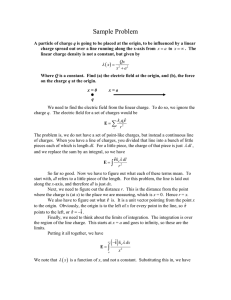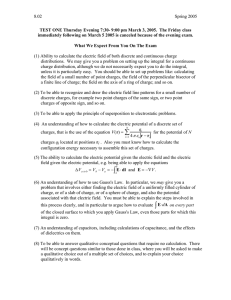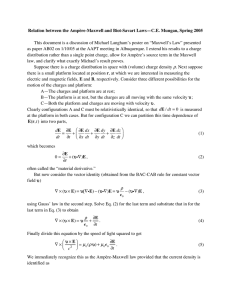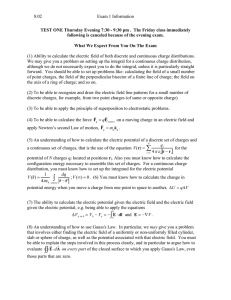PHYS 3323 Lesson 4 Electrostatics I I.
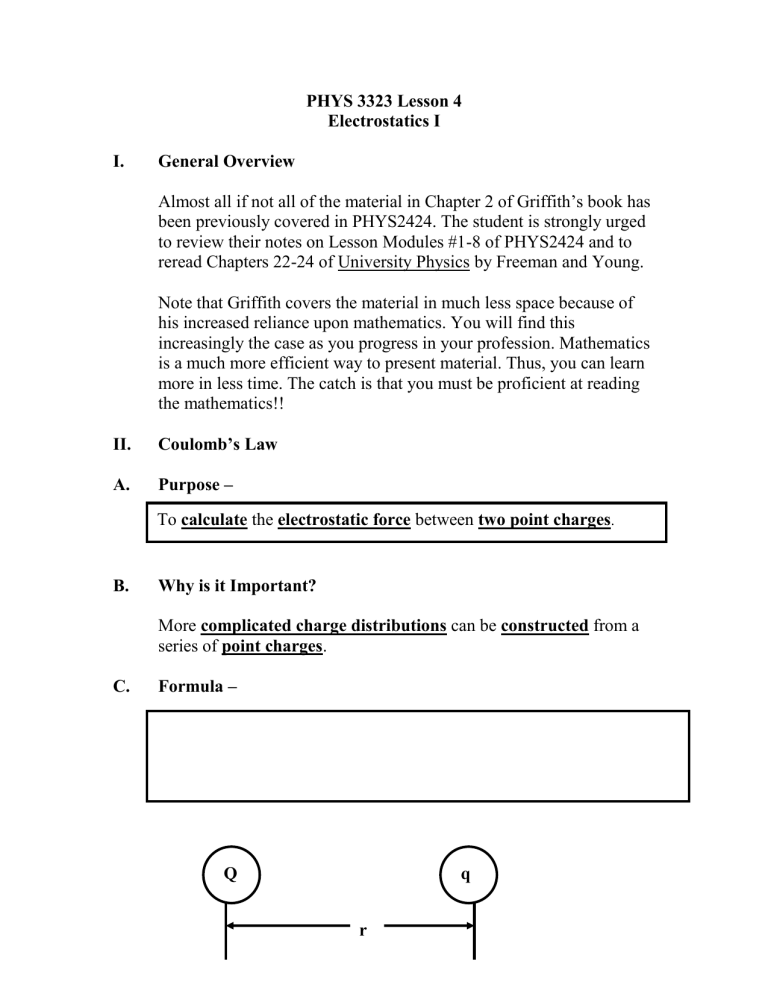
PHYS 3323 Lesson 4
Electrostatics I
I. General Overview
Almost all if not all of the material in Chapter 2 of Griffith’s book has been previously covered in PHYS2424. The student is strongly urged to review their notes on Lesson Modules #1-8 of PHYS2424 and to reread Chapters 22-24 of University Physics by Freeman and Young.
Note that Griffith covers the material in much less space because of his increased reliance upon mathematics. You will find this increasingly the case as you progress in your profession. Mathematics is a much more efficient way to present material. Thus, you can learn more in less time. The catch is that you must be proficient at reading the mathematics!!
II.
Coulomb’s Law
A. Purpose –
To calculate the electrostatic force between two point charges .
B. Why is it Important?
More complicated charge distributions can be constructed from a series of point charges .
C. Formula –
Q q r
EXAMPLE:
Calculate the force a -2.0
C point charge located at (-3,4) experiences due to a 3.0
C point charge at (2,-3).
D. Multiple Charges
To find the net force a test charge q experiences due to a collection of other point charges, we just sum the force due to each point charge using Coulomb’s Law.
F
1
4π ε
0 q i
N
1
Q i r i
2 r ˆ i
Although all source charges are really discrete entities (electrons, protons, etc), we can usually treat the system as composed of a continuous charge distribution when working macroscopic problems!!
This allows us to replace a sum with large numbers of terms (maybe
10 +23 terms) with an integral.
F
1
4π ε
0 q all
charges r r ˆ
2 dq
A fundamental difficulty with the direct application of Coulomb’s law is the evaluation of the sum or integral!
III. Electric Field
A. Purpose –
To enable us to quickly determine the electric force that a test charge would experience at a particular point in space.
B. Definition –
C. Electric Field Due to a Point Charge
From Coulomb’s law, we can obtain the relationship for the electric field due to a point charge Q as shown below:
Q
E
1
4π ε
0 r
Q
2 r ˆ
This is a useful relationship and should be put to memory!
D.
Collection of Point Charges
The electric field for a collection of point charges can be obtained from our previous work in part 2.D.
Discrete Case
Continuous Case
E
1
4π ε
0
N
i
1
Q i r i
2 r ˆ i
E
1
4π ε
0 all
charges r r ˆ
2 dq
We see that all the difficulties of using Coulomb’s law are contained in the calculation of the electric field. Once this vector function has been calculated once, you can easily find the electric force felt by any test charge without repeating the calculation of the difficult integral or sum! This is the same process that use when calculating the weight of an object near the earth. All of the calculations involving the mass and radius of the earth are contained in g (the acceleration of a falling body - 9.8 m/s 2 ).
E. Volumes, Surfaces, and Lines
To evaluate the integral above, you must be able to write the infinitesimal charge dq in terms of the spatial variables. This is done by using the volume, surface or linear charge density depending on the problem (see your PHYS2424 notes).
Volume Surface Area Linear dq
ρ dv dq
σ dA dq
λ dx
EXAMPLE (Problem 2.5):
Find the electric field a distance Z above the center of a circular loop of radius r which carries a uniform line charge of
as shown below: z
P
R
SOLUTION:
1. Let us set the origin of our coordinate axis at the center of the circle.
This will simplify the form of our final result.
2. We now draw an infinitesimal piece of test charge on our figure and show the electric field arrow it would produce.
3. The magnitude of the electric field at point P due to our infinitesimal point charge is given by
4. From our drawing, we can see that due to symmetry only the zcomponent of the electric field will remain after we have added up all of the infinitesimal point charges. The z-component of the electric field due to our infinitesimal point charge is given by
5.
Now that we have the integrand, we can integrate over the entire charge distribution.
6.
We now check our results to see if it makes physical sense! If we are very far away from the ring (i.e. z >> R) the ring should appear as a point charge source!
F. Direct Application of Coulomb’s Law
The direct application of Coulomb’s law is often difficult since it involves solving a complicated vector integral! Although we may be able to solve the integral numerically using a computer for a specific charge distribution, we want analytical solutions in many cases so that we can gain insight into how a system works (a collection atoms for instance).
IV.
Gauss’ Law of Electric Fields
As we learned in PHYS2424, we can find the electric field for a system with a high level of symmetry without actually doing the integral by Gauss’ Law of Electric Fields. See your PHYS2424 notes!
We spent two whole lesson modules on this material!
A. Electric Flux
The electric flux that penetrates a surface is proportional to the number of electric field lines that penetrates the surface. It is given by the formula:
Φ
E
E
d A
In general, the electric flux is not a useful concept since you can’t calculate the electric flux without already knowing the electric field!!
However, the electric flux through a closed surface can be calculated without knowing the electric field and this is the key!!
B. Electric Flux Through a Closed Surface
Gauss’ Law of Electric Fields tells us that the electric flux through any closed surface is proportional to the net charge contained in the volume enclosed by the surface!
Integral Form
Φ
E
Differential Form
surface
E
d A
Q enclosed
ε
0
E
ρ
ε
0
The differential form is obtained from the integral form of the law by using the divergence theorem. It says that the source of radial flow of the electric field is charge!!
C. Applying Gauss’ Law for Electric Fields
We begin by writing the integrand in Gauss’ law explicitly.
If we can find a surface or surfaces along which the magnitude of the electric field is constant and the angle between the electric field and the surface is constant then we can pull the cosine and magnitude of the electric field outside the integral.
E cos
dA surface
Q enclosed
ε
0
The remaining integral is just the surface area!!
Thus, we have the amazingly simple result:
E
ε
0
Area
Q enclosed through which flux flows
How often is it possible to use this trick. The answer is rarely!! The system must have a large degree of symmetry (sphere, cylinder, or cube) and you have to already know the shape of the electric field lines in order to choose the appropriate Gaussian surface!! However, if you do have a system that meets these requirements then Gauss’ law solves the problem quickly and elegantly!!
We have done all the basic problems Gauss law problems in
PHYS2424 and used it in PHYS3343 to consider Rutherford scattering and the size of the nucleus. Review your notes!!
Note For Instructor
Depending on available class time, you may want to:
1. Set up some E-field demos for common configurations using the
Van de Graaff generator and thread or the overhead electrostatic kit.
2. Talk about spatial dependence of E-field for sphere, cylinder, and plane.
3. Rutherford scattering application


